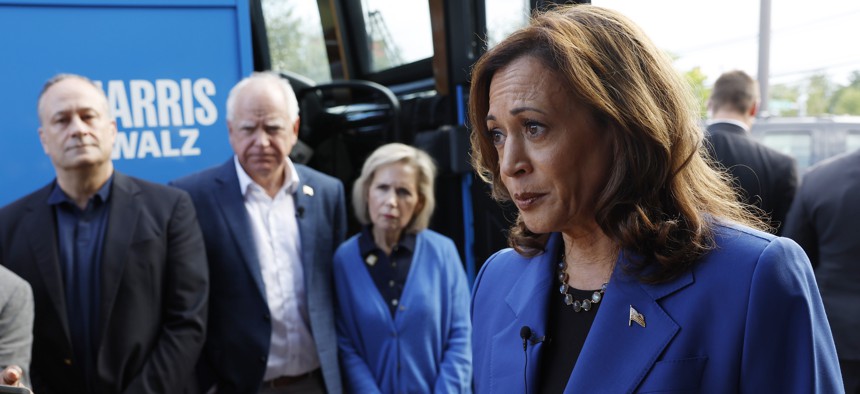Housing finally becomes a focus in a presidential campaign

Democratic presidential candidate, U.S. Vice President Kamala Harris speaks to reporters outside of Primanati Bros. Restaurant on August 18, 2024 in Moon Township, Pa. Anna Moneymaker via Getty Images
With home prices at record highs, the Harris-Walz campaign has outlined a policy agenda that it says will spur construction of 3 million new units in four years.
From President Joe Biden’s last-minute decision to drop out of the election to former President Donald Trump’s legal troubles, many aspects of the current election cycle are unprecedented. But for Jim Tobin, president and CEO of the National Association of Home Builders, this year is notable for another reason.
“For the first time in my career, housing and housing supply is front and center in a presidential campaign,” said Jim Tobin, president and CEO of the National Association of Home Builders. ”That's really important because housing has become so far out of reach for so many Americans [and] we've got to solve that problem.”
Home prices hit record highs this year and more Americans are dedicating large shares of their incomes to housing costs. The country is facing a shortage of between 4 million and 7 million units, causing rent and home prices to skyrocket.
The Harris-Walz campaign recently outlined a slew of proposals it hopes will spur construction of 3 million new units in four years. As part of the campaign’s broader economic agenda, the housing plans include efforts to bolster the housing supply, such as strengthening the Low-Income Housing Tax Credit and creating a new tax incentive for developers that build starter homes. A proposed $40 billion innovation fund — a sum that doubles a similar initiative under the Biden administration — would similarly “empower developers and homebuilders to design and build rental and housing solutions that are affordable,” according to a campaign press release.
These policies are notable in that they specifically create affordable housing, said Janneke Ratcliffe, vice president of the Housing Finance Policy Center at the Urban Institute. There’s an overall shortage of units across the country, and the units that are being built are typically too expensive for the average household. Given everything that goes into development — land prices, regulatory burdens, materials and labor costs — it’s more economical for builders to develop high-end units rather than homes affordable to lower- and middle-income households, she said.
Harris is also looking to streamline permitting processes at the state and local level. Research shows that easing regulations around development — such as reducing parking minimums and single-family zoning — is a powerful tool in spurring development.
The most important role the federal government can play in this effort is to provide funding to update regulations, Ratcliffe said, and leave reforms up to state and local governments. Flexible funding through initiatives like the Pathways to Removing Obstacles Housing Program, or PRO Housing, which grants funding to communities that are actively working to expand and preserve housing.
“There's a lot of things that the local governments can do that address the specific needs and situations of their market,” she said. “The federal funding helps motivate, helps make it possible, but it leaves a lot of the decision making to the locals.”
Regulatory burdens across all levels of government increase development costs by about 24% for a single-family unit and 41% for multifamily, Tobin said. Most of that comes from local requirements, but not all of it. The National Association of Home Builders would like to see Harris go further and address the federal regulations that slow down development, Tobin said. A new regulation from the Biden administration, for example, requires that new homes sold to Federal Housing Administration borrowers must meet 2021 energy codes, a stipulation that reduces homeowner energy bills but adds tens of thousands of dollars to development costs.
“On day one for either administration, that's our number one ask: roll back that regulation,” he said.
So far in this campaign, Donald Trump has said little about his plans to tackle the housing crisis. He has suggested the president should play a role in setting interest rates, a move that could impact mortgages. The 2024 Republican Party Platform also proposes cutting interest rates, offering tax incentives and support for first-time homebuyers, and reducing regulations, but offers few details. Both campaigns have also suggested opening up some federal lands for housing development.
Trump’s advantage is he has a track record he can point to, including reforming federal regulations to streamline development and establishing the White House Council on Eliminating Regulatory Barriers to Affordable Housing.
Even if new policies spur development, it will be years before many of those units come online. In the meantime, the competition to buy homes is stiff, Ratcliffe said, and it’s difficult for first-time buyers who rely on financing to compete against cash buyers or real estate investors. That’s where Harris’ plan for a downpayment assistance program — which would give some first-time buyers up to $25,000 with additional support for first-generation buyers — could be a game changer for some households. Harris’ plans to crack down on corporate landlords could also remove formidable competitors from the market and build on efforts already moving through Congress.
Still, a lot of what happens over the next few years will play out in neighborhoods and city halls, Ratcliffe said.
“The federal government can lead the way, but a lot of the solutions rely upon what happens at the local level,” she said. “Real estate is fundamentally a local situation.”






